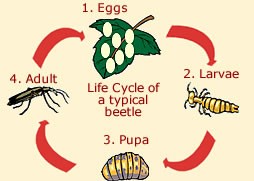
Reproduction
Aphodius prodromus beetles reproduce
sexually. They have the typical life cycle of a beetle which
involves laying eggs in which develop to become larvae, pupae, and
then an adult. Below is a simple diagram of the life cycle of
beetles (Animal Corner 2003-2013).
Interestingly enough, A. prodromus beetles do not actually lay
their eggs in dung pats. Instead they lay their
eggs in the soil near dung piles (Gittings
and Giller 1997). The larvae then develop there on the
roots of plants and decomposing plant matter (Gittings
and Giller 1997). It is unsure what exactly the larvae
food source is. It is most likely a combination of both dung,
brought to where the larvae are developing, and decomposing plant
matter that they use(Sladecek et al. 2013).
This type of dung beetle can be considered a relocator, meaning
their larvae do not reach the dung pat at any point in their
development (Sladecek et al. 2013).
Relocating adults do one of two things to create a nest for their
eggs (Arnaudin 2012; Sladecek et al. 2013).
One type of relocating is called tunneling. Tunnelers are
beetles that burrow down into the soil forming nesting chambers
directly underneath, or nearby, the dung source. These beetles
use dung and make balls out of it to use as the food source for the
larvae. The other method is called rolling. The beetles
also make balls out of dung, but they differ from tunnelers because
they roll the balls away from the dung pile and shallowly bury it in
the soil. They then will lay a single egg on top of it. (Arnaudin
2012).
A. prodromus female beetles have an accumulated sequential type
of ovarian development. Females may have up to twenty-three
mature eggs in their ovaries. First, eggs develop in separate
ovarioles until there is a mature egg in the individual ovarioles.
At that point, the second egg starts to develop sequentially in the
ovarioles, while the mature eggs accumulate in the females two
ovaries. (Gittings and Giller 1997).
Once all the eggs are mature, the female leaves the dung pile and
goes to lay her eggs in the soil. After fertilization, the eggs then go through the
process of being larvae, to pupae, and then eventually an adult.
The general life cycle of a beetles is
as follows:
Beetles undergo complete metamorphism. They start as an egg,
hatching about four to nineteen days after fertilization. The
larval stage marks a period of tremendous growth. The beetles
molt their exoskeleton many times and grow in size and elongates.
After growth they enter the pupal stage, which is a period of
transforming into an adult (Animal Corner
2003-2013). For A. prodromus, this pupal stage takes
place over the winter months. As an adult, A. prodromus
beetles have what is considered to be an early successional
occurrence, meaning their adult flight period occurs in the spring,
and then again in autumn (Gittings and
Giller 1997). Adult flight period is defined as being the
period of adulthood, meaning they have wings (Yoshida and Katakura
1986). In A. prodromus beetles, the time in between
their spring and autumn adult flight periods is marked by an
inactive period (Gittings and Giller 1997).
In the autumn season, A. prodromus adults feed on the dung before
hibernation during the wintering months. The occurrence of A.
prodromus beetles in early spring is most likely a result of the
beetles coming out of hibernation from the winter months (Holter
1982).
Back to Home On to Interactions
